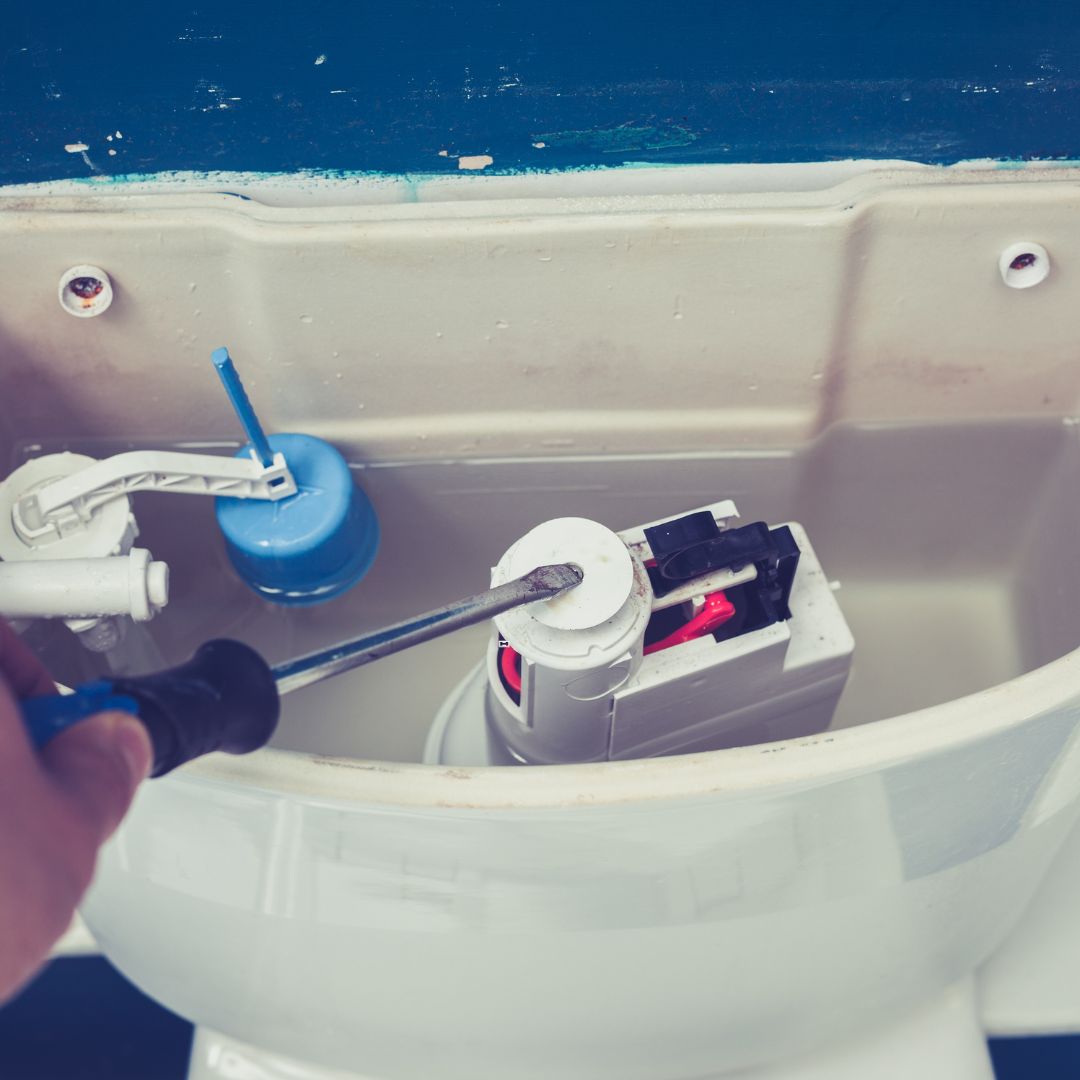Knowing the parts of your toilet can save you time, money, and frustration. Every flush depends on a few key components working together—some you can see, others hidden inside the tank. When something goes wrong (like constant running, weak flushing, or leaks around the base), the issue usually traces back to one or two worn-out parts that are cheap and easy to replace.
This guide breaks down every part of a standard American toilet, explains its function, and shows which problems each one can cause when it fails—plus which replacement parts you can find at Lowe’s to fix them fast.
🧱 The Two Main Sections of a Toilet
Every residential toilet is made up of two main assemblies:
-
The Tank (upper portion) – stores water and controls the flushing mechanism.
-
The Bowl (lower portion) – receives waste and channels it into the drain via the trapway.
Let’s go through each section piece by piece.
💧 Tank Components: The Heart of the Flush System
1. Flush Handle (Trip Lever)
-
What it does: Activates the flush by lifting the flapper inside the tank.
-
Common issues: Handle feels loose or sticks, flush doesn’t engage.
-
Likely cause: The handle arm or chain connection inside the tank is corroded or disconnected.
-
Quick fix: Replace with a universal Fluidmaster Adjustable Toilet Tank Lever — fits most toilets and installs in minutes.
2. Chain or Lift Wire
-
What it does: Connects the handle arm to the flapper.
-
Common issues: Flush won’t start or handle feels too loose/tight.
-
Likely cause: Chain length incorrect or rusted link.
-
Quick fix: Adjust the chain so there’s about ½ inch of slack. If corroded, replace it—usually included in flapper repair kits.
3. Flapper or Flush Valve Seal
-
What it does: Seals the tank and releases water into the bowl during a flush.
-
Common issues: Constantly running toilet, slow tank refill, or hissing sounds.
-
Likely cause: The rubber flapper has warped or deteriorated from age or cleaning chemicals.
-
Quick fix: Replace with a Fluidmaster Universal Flapper. They cost under $10 and fix 90% of “running toilet” problems.
4. Flush Valve Assembly
-
What it does: Houses the flapper and directs water through the tank opening into the bowl.
-
Common issues: Water leaking into the bowl even after replacing the flapper.
-
Likely cause: The valve seat is cracked or pitted.
-
Quick fix: Replace the entire flush valve kit—Lowe’s carries universal models like the Korky 2-Inch Complete Flush Valve Repair Kit, ideal for most standard toilets.
5. Fill Valve
-
What it does: Refills the tank after each flush and stops automatically when full.
-
Common issues: Water won’t stop running or tank refills very slowly.
-
Likely cause: Worn internal diaphragm or stuck float.
-
Quick fix: Replace with a modern, quiet-fill option like the Fluidmaster 400A Universal Fill Valve — a simple DIY upgrade that takes about 10 minutes.
6. Float / Float Cup
-
What it does: Rises with the tank’s water level to tell the fill valve when to shut off.
-
Common issues: Constant trickling water or incomplete refills.
-
Likely cause: The float is set too high/low or waterlogged.
-
Quick fix: Adjust the float height screw or clip on the fill valve. Replace if cracked.
7. Overflow Tube
-
What it does: Prevents overfilling by diverting excess water into the bowl.
-
Common issues: Constant water running into the bowl.
-
Likely cause: Water level set too high or fill valve malfunctioning.
-
Quick fix: Lower the fill level or replace the fill valve.
8. Tank Bolts and Gasket
-
What they do: Secure the tank to the bowl and create a watertight seal.
-
Common issues: Leaks at tank-bowl junction or rocking tank.
-
Likely cause: Deteriorated rubber washers or loose bolts.
-
Quick fix: Replace with a tank-to-bowl bolt set and new gasket. Always hand-tighten evenly to avoid cracking the porcelain.
9. Tank Lid
-
What it does: Simply covers the top of the tank, keeping debris out.
-
Common issues: Cracks from accidental drops.
-
Fix: Replace with a matching brand lid—take a photo of your model number (usually inside the tank) to find the right fit.
🚽 Bowl Components: The Business End
10. Toilet Seat
-
What it does: Provides a comfortable, cleanable surface for use.
-
Common issues: Loose hinges, cracks, or slamming lids.
-
Quick fix: Tighten mounting bolts or replace with a soft-close seat for added comfort.
Try the Project Source Slow-Close Elongated Toilet Seat — durable and affordable.
11. Rim Holes (or Jet Holes)
-
What they do: Allow water to flow around the bowl’s rim during a flush, cleaning the sides.
-
Common issues: Weak flush or dirty bowl despite normal tank operation.
-
Likely cause: Mineral buildup clogging the rim holes.
-
Quick fix: Use vinegar or a wire hanger to clear deposits, or soak overnight with a descaling product.
12. Siphon Jet
-
What it does: Located at the bottom of the bowl; provides the main flush push.
-
Common issues: Weak flush, waste not clearing completely.
-
Likely cause: Hard-water mineral buildup inside jet.
-
Quick fix: Clean with a small brush and vinegar or CLR. If the clog is internal, replacement may be needed.
13. Trapway
-
What it does: Curved internal channel that connects the bowl to the drain outlet, maintaining a water seal to block sewer gas.
-
Common issues: Frequent clogs or gurgling.
-
Likely cause: Obstruction, poor design, or buildup inside the bend.
-
Quick fix: Use a flange plunger first; if recurring, a closet auger (toilet snake) is your friend.
14. Wax Ring (or Wax-Free Seal)
-
What it does: Seals the toilet base to the floor flange, preventing water and sewer gas leaks.
-
Common issues: Leaks at the base, bad smell, or rocking toilet.
-
Likely cause: Wax ring compressed, cracked, or misaligned.
-
Quick fix: Replace with a Fluidmaster Wax-Free Seal Kit — less mess and reusable if you ever need to reset the toilet.
15. Closet Bolts and Caps
-
What they do: Anchor the toilet to the floor flange.
-
Common issues: Toilet rocks or leaks at the base.
-
Likely cause: Loose or corroded bolts.
-
Quick fix: Tighten gently and evenly. If threads are rusted, replace bolts and caps—cheap and simple.
16. Shut-Off Valve & Supply Line
-
What they do: Control and deliver water to the tank.
-
Common issues: Leaking, corrosion, or difficulty turning.
-
Likely cause: Old compression fittings or stiff valve stems.
-
Quick fix: Replace with a SharkBite ¼ Turn Compression Angle Stop Valve and a new Fluidmaster Braided Stainless Steel Toilet Supply Line for reliable, long-lasting performance.
🧩 How These Parts Work Together
Here’s a quick visual flow of the process:
-
You press the handle → chain lifts the flapper.
-
Water rushes from tank to bowl through the flush valve.
-
The siphon jet and rim holes push waste through the trapway.
-
As water level drops, the flapper reseals and the fill valve refills the tank.
-
The float rises, shutting off water when the set level is reached.
When one component misbehaves—say, the flapper doesn’t seal or the fill valve sticks—the whole rhythm breaks, causing running water or weak flushes.
🧠 Quick Reference: Common Toilet Problems & Likely Culprits
| Problem | Likely Cause | Recommended Fix |
|---|---|---|
| Toilet keeps running | Worn flapper or misaligned float | Replace flapper or adjust fill valve |
| Weak flush | Clogged jet holes or low tank water | Clean rim/siphon jets, adjust fill level |
| Water leaking around base | Failed wax ring or loose bolts | Replace wax ring, tighten bolts evenly |
| Handle won’t flush | Broken chain or trip lever | Reconnect or replace lever assembly |
| Water leaking into bowl | Cracked flush valve seat | Replace flush valve kit |
| Gurgling or slow drain | Partial trapway clog | Use toilet auger or snake |
| Noisy refill | Faulty fill valve | Replace fill valve with quiet model |
| Tank sweating | Humid room, cold water | Add anti-condensation liner or mix valve |
🧰 Recommended Replacement Parts & Tools (Lowe’s)
🧾 Conclusion
A modern toilet is a simple yet ingenious system where each part has one job—and when it stops doing that job, the symptoms are usually easy to identify. With a basic understanding of your tank and bowl components, you can spot leaks early, replace worn parts confidently, and extend the life of your fixture by years.
Whether you’re doing your own repairs or calling Colin Can Help, knowing what each part does makes every conversation—and every fix—faster, smarter, and less stressful.
❓ FAQ
1. How long do toilet parts last?
Most internal parts last 5–10 years. Rubber flappers and fill valves are the first to wear out due to hard water or cleaners.
2. Why does my toilet randomly turn on by itself?
This “phantom flush” means water is slowly leaking from the tank into the bowl—usually a worn flapper or cracked flush valve seal.
3. How often should I replace my wax ring?
Only when removing or resetting the toilet. Wax doesn’t “expire,” but compression or misalignment causes leaks.
4. Is it okay to use drop-in tank tablets?
Avoid them. They degrade rubber seals and shorten the life of internal parts. Use bowl cleaners instead.
5. Can I replace these parts myself?
Yes—most repairs take 15–30 minutes and basic tools. If you notice water damage or need to reset the toilet, it’s smart to call a pro.

